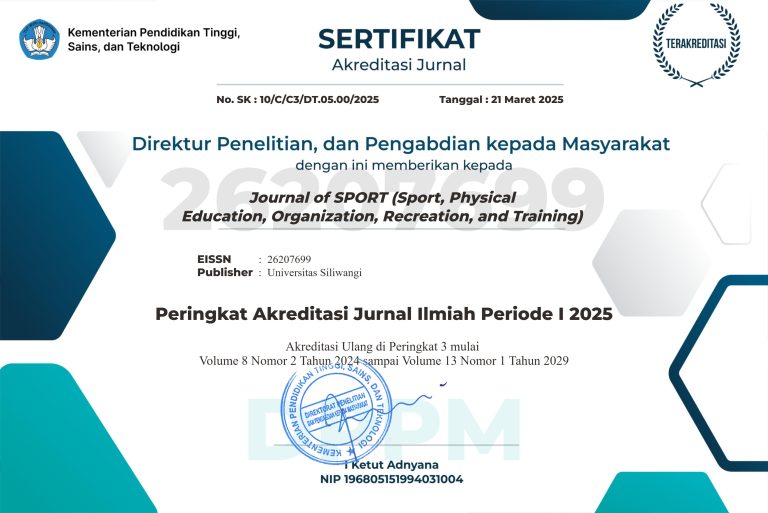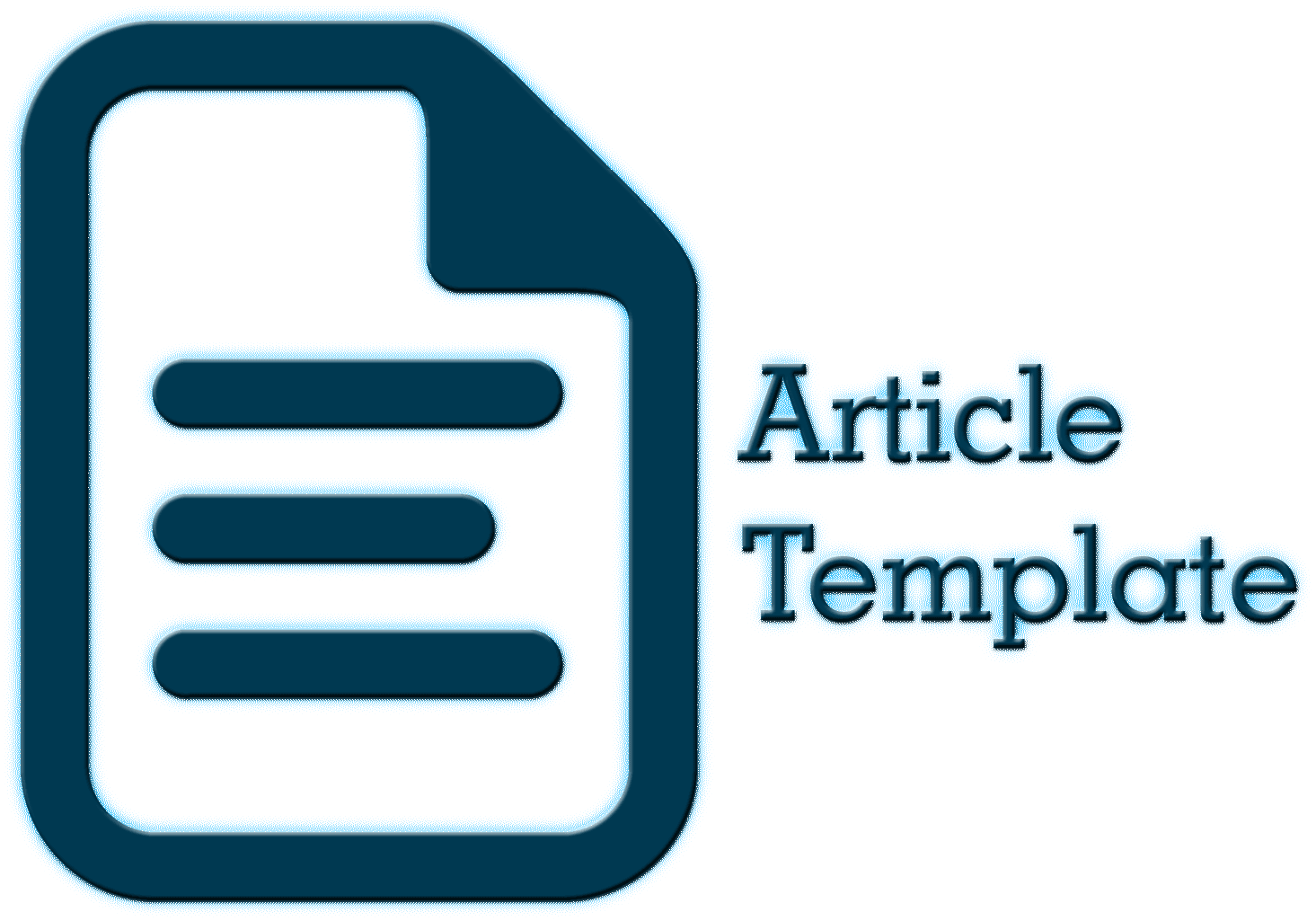HUBUNGAN PHYSICAL LITERACY (LITERASI FISIK) DENGAN INDEKS MASSA TUBUH SISWA PADA KEGIATAN EKSTRAKURIKULER BULUTANGKIS
Abstrak
Penelitian ini bertujuan untuk mengetahui hubungan physical literacy (literasi fisik) dengan indeks massa tubuh. Metode yang digunakan dalam penelitian ini adalah deskriptif kuantitatif dengan pendekatan korelasional. Teknik sampling yang digunakan adalah total sampling dari keseluruhan populasi sebanyak 30 siswa yang terdiri dari 12 siswa laki-laki dan 18 siswa perempuan, dengan rata-rata usia sampel 16 tahun. Instrumen pada penelitian ini diadopsi dari precieved physical literacy instrument (PPLI) dalam edisi Bahasa Indonesia. Berdasarkan perhitungan dan analisis data, diperoleh rata-rata indeks massa tubuh siswa adalah yang berada pada kategori berat badan normal sebesar (63%). Berdasarkan perhitungan nilai korelasi didapatkan adanya korelasi negatif dengan kekuatan yang sangat lemah sebesar -0.103. Kesimpulan: literasi fisik dengan indeks masa tubuh memiliki hubungan yang sangat lemah dan berlawanan arah, adapun maksud dari berlawanan arah yaitu, ketika literasi fisik meningkat maka indeks masa tubuh akan menurun, begitupun sebaliknya, ketika literasi fisik menurun maka indeks masa tubuh akan meningkat.
Kata Kunci
Teks Lengkap:
PDFReferensi
Ariesthi, K. D., Fitri, H. N., & Paulus, A. Y. (2020). PENGARUH INDEKS MASSA TUBUH (IMT) DAN AKTIVITAS FISIK TERHADAP KEJADIAN DISMENORE PADA REMAJA PUTRI DI KOTA KUPANG (Vol. 4).
Asyera Sinulingga, P., Andayani, L. S., & Lubis, Z. (2021). The Influence of Online School on Sedentary Behavior at Risk of Obesity in Adolescents Aged 15-19 Years. In Jurnal Kesehatan (Vol. 12, Issue 3). Online. http://ejurnal.poltekkes-tjk.ac.id/index.php/JK
Baroroh, I. (2022). Peningkatan Pengetahuan tentang Pemenuhan Gizi Remaja dan Edukasi Pencegahan Stunting. Jurnal ABDIMAS-HIP, 3.
Bohari, B., Nabila, M., Sijabat, A. I. Y., Farendhiya, A., Tsany, R. D., Akta W, U. A., Hidayah, R. N., Setyaningsih, P., Anggini, M. T., & Wulan Y. P, Y. (2022). Physical Activity, Eating Habits, Nutrition Knowledge and Nutritional Status of Central Obesity in Adolescents. Journal of Health and Nutrition Research, 1(1), 11–16. https://doi.org/10.56303/jhnr.v1i1.4
Cairney, J., Dudley, D., Kwan, M., Bulten, R., & Kriellaars, D. (2019). Physical Literacy, Physical Activity and Health: Toward an Evidence-Informed Conceptual Model. In Sports Medicine (Vol. 49, Issue 3, pp. 371–383). Springer International Publishing. https://doi.org/10.1007/s40279-019-01063-3
Edwards, L. C., Bryant, A. S., Keegan, R. J., Morgan, K., & Jones, A. M. (2017). Definitions, Foundations and Associations of Physical Literacy: A Systematic Review. In Sports Medicine (Vol. 47, Issue 1, pp. 113–126). Springer International Publishing. https://doi.org/10.1007/s40279-016-0560-7
Fitri, Y., & Sri Mulyani, N. (2017). HUBUNGAN AKTIVITAS FISIK DENGAN IMT DAN KOMPOSISI LEMAK TUBUH (The Association Between Physical Activity with Body Mass Index (BMI) and Body Fat Composition). In Eva Fitrianingsih & Suryana 114 Jurnal AcTion (Vol. 2, Issue 2).
Friskawati, G. F., & Stephani, M. R. (2021). Analysis Research Trends of Physical Literacy in Indonesia. Jurnal Pendidikan Jasmani Dan Olahraga, 6(2). https://doi.org/10.17509/jpjo.v6i2.38298
Im, M. H., Hughes, J. N., Cao, Q., & Kwok, O. M. (2016). Effects of Extracurricular Participation During Middle School on Academic Motivation and Achievement at Grade 9. American Educational Research Journal, 53(5), 1343–1375. https://doi.org/10.3102/0002831216667479
Infante, J. R., Reyes, C., Ramos, M., Rayo, J. I., Lorente, R., Serrano, J., DomÃnguez, M. L., GarcÃa, L., Durán, C., & Sánchez, R. (2013). The usefulness of densitometry as a method of assessing the nutritional status of athletes. Comparison with body mass index. Revista Española de Medicina Nuclear e Imagen Molecular (English Edition), 32(5), 281–285. https://doi.org/10.1016/j.remnie.2013.07.012
Lundvall, S. (2015). Physical literacy in the field of physical education - A challenge and a possibility. In Journal of Sport and Health Science (Vol. 4, Issue 2, pp. 113–118). Elsevier B.V. https://doi.org/10.1016/j.jshs.2015.02.001
Naser, M. Z. (2022). Deriving mapping functions to tie anthropometric measurements to body mass index via interpretable machine learning. Machine Learning with Applications, 8, 100259. https://doi.org/10.1016/j.mlwa.2022.100259
Notara, V., Kanellopoulou, A., Diamantis, D. V., Antonogeorgos, G., Magriplis, E., Paola Rojas-Gil, A., Kornilaki, E. N., I. Kosti, R., Lagiou, A., & Panagiotakos, D. B. (2021). Extracurricular activities and childhood obesity: An epidemiological study among 10–12 years old children. Children and Youth Services Review, 120. https://doi.org/10.1016/j.childyouth.2020.105760
Nuttall, F. Q. (2015). Body mass index: Obesity, BMI, and health: A critical review. In Nutrition Today (Vol. 50, Issue 3, pp. 117–128). Lippincott Williams and Wilkins. https://doi.org/10.1097/NT.0000000000000092
Park, J. H., Moon, J. H., Kim, H. J., Kong, M. H., & Oh, Y. H. (2020). Sedentary Lifestyle: Overview of Updated Evidence of Potential Health Risks. Korean Journal of Family Medicine, 41(6), 365–373. https://doi.org/10.4082/KJFM.20.0165
Penelitian, A., Baskora, R. A., & Woro, O. (2011). Sistem Informasi Perencanaan Pola Hidup Sehat melalui Keseimbangan Aktivitas dan Asupan Makanan. In Jurnal Media Ilmu Keolahragaan Indonesia (Vol. 1). http://journal.unnes.ac.id/index.php/miki
Roetert, E. P., & Jefferies, S. C. (2014). Embracing Physical Literacy. Journal of Physical Education, Recreation & Dance, 85(8), 38–40. https://doi.org/10.1080/07303084.2014.948353
Rudd, J. R., Pesce, C., Strafford, B. W., & Davids, K. (2020). Physical Literacy - A Journey of Individual Enrichment: An Ecological Dynamics Rationale for Enhancing Performance and Physical Activity in All. In Frontiers in Psychology (Vol. 11). Frontiers Media S.A. https://doi.org/10.3389/fpsyg.2020.01904
Sum, K. W. R., Cheng, C. F., Wallhead, T., Kuo, C. C., Wang, F. J., & Choi, S. M. (2018). Perceived physical literacy instrument for adolescents: A further validation of PPLI. Journal of Exercise Science and Fitness, 16(1), 26–31. https://doi.org/10.1016/j.jesf.2018.03.002
Tremblay, M. S., Costas-Bradstreet, C., Barnes, J. D., Bartlett, B., Dampier, D., Lalonde, C., Leidl, R., Longmuir, P., McKee, M., Patton, R., Way, R., & Yessis, J. (2018). Canada’s Physical Literacy Consensus Statement: Process and outcome 11 Medical and Health Sciences 1117 Public Health and Health Services. BMC Public Health, 18. https://doi.org/10.1186/s12889-018-5903-x
Whitehead, M. (2006). Developing Physical Literacy. Canadian Sport Centers. https://sportforlife.ca/wp-content/uploads/2016/12/DPL_ENG_Feb29.indd_.pdf
Whitehead, M. (2013). Definition of Physical Literacy and Clarification of related Issues. Journal of Sport Science and Physical Education. https://www.icsspe.org/sites/default/files/bulletin65_0.pdf#page=29
DOI: https://doi.org/10.37058/sport.v7i3.8795
Refbacks
- Saat ini tidak ada refbacks.
##submission.copyrightStatement##
Journal of SPORT (Sport, Physical Education, Organization, Recreation, and Training)
Program Studi Pendidikan Jasmani
Fakultas Keguruan dan Ilmu Pendidikan
Universitas Siliwangi
Jl. Siliwangi No. 24 Kota Tasikmalaya - 46115
email: penjas@unsil.ac.id
e-ISSN: 2620-7699 ; p-ISSN: 2541-7126

This work is licensed under a Creative Commons Attribution-ShareAlike 4.0 International License.
INDEX BY
1.png)












